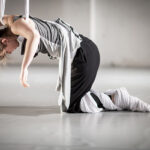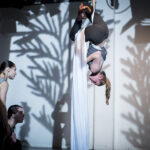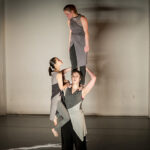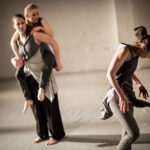Study / Shames
„Those who are not able to poses a certain proportion of a shame and justice are nothing but an infection of a village, and should be killed.”
Hartl and Hartlová define the emotion of shame as a reaction to any wrongdoing or violation of social norms and/or rules. Zimbardo and Henderson list a series of symptoms, in which shy reactions manifest on the physiological level: fast heartbeat, dry mouth, sweating skin. Shame has a wider psychological sense, in the narrower sense, you can distinguish different types of shame; sexual, moral and social. To experience shame, confrontation between a personal imperfection or failure and one's social environment is essential. Shame is associated with loss of capability in the public's eyes, unconfidence, embarrassment, etc.
Reviews
Taneční aktuality
Taneční zóna
(…) The contrast between the three figures was apparent from the very beginning. Actually, the whole show benefited from the conscious play with this contrast. This kind of confidence helped to lead the general topic of shame to closely related situations of (intended) awkwardness and the matter of dominance, all presented in a very physical way. In one particular moment of the show, one of the smaller performers wanted to rise above the other small one and did so by climbing on her taller mate. In the end, both small interpreters were climbing on Eva Stará without any sense of her being overburdened, or exhausted. This was another brilliant moment of play with contrast. Further, seemingly indifferent behavior during the execution of numerous acrobatic figures raised the show even further above the level of an ordinary student’s performance. (…) What has to be highly appreciated, is the work with simplicity. So far, many interpreters have attempted to express a complex topic in a very simple way, but rarely successfuly interpretated this “bright” idea. However, in case of this performance, the audience felt connected with the interpreters during the whole show. Different situations and contrasts worked well from a theatrical point of view. (…) Study has a very nice final shape. The performance works well with its originality and unusual simplicity. It has the potential to attract a broad range of audience thanks to the combination of elements from the area of contemporary dance, mime, and new circus.
(…) The dancers benefit from and use their different movement skills and qualities. (…) In some acrobatic acts, Andrea stands a little apart, her efforts to engage in them give rise to comic situations. In a particular scene this humor appears as Andrea and Karolína – both small – compete over who is taller. Karolina solves it easily by climbing on Eva's shoulders. In vain, Andrea tries to climb up too, but when the girls meet again on the ground, she has the upper hand, being taller by about half a forehead. (…) In fact, there is so much play and space given to the description of their characteristic bodies that it practically imposes the base of the whole show. The three young students are evidently aware of their different possibilities and are able to connect them into one functional piece. Working well with space and their only prop – an aerial silk, which isn't used only as a piece of acrobatic equipment. But what is particularly exceptional amongst these students is their detachment, humor, and self-irony. The performers are obviously enjoying themselves and are able to transfer their enthusiasm to the audience.











